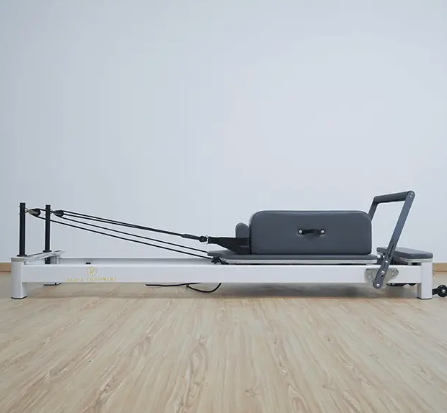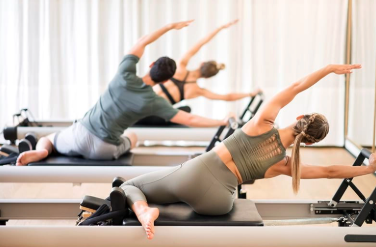T: +86-150-0640-1267
E: susan.liu@jnsenya.com
E: susan.liu@jnsenya.com
Room 708, Y1, Wanda Apartment, No.57 Gongye South Road, Jinan, China (shandong) Pilot Free Trade Zone
Views: 0 Author: Site Editor Publish Time: 2025-09-19 Origin: Site











The Pilates reformer machine is renowned for its ability to build strength, improve flexibility, and enhance overall well-being. But how often should you incorporate this practice into your routine to maximize benefits? This guide will provide detailed answers to help you optimize your Pilates reformer sessions for the best results.
The Pilates Reformer is a sophisticated piece of exercise equipment that brings a new dimension to the practice of Pilates. It is designed to enhance strength, flexibility, and posture through a series of controlled movements that engage the entire body. The machine is equipped with a sliding carriage that moves along a frame, adjustable springs that provide resistance, and pulleys and straps that offer support. This setup allows for a dynamic workout that can be tailored to individual needs and fitness levels.
The Aluminum Pilates Reformer, in particular, is celebrated for its durability and lightweight construction. This makes it an excellent choice for both home and studio settings, appealing to fitness enthusiasts of all levels. Unlike traditional mat Pilates, which relies on body weight for resistance, the Reformer machine’s adjustable resistance levels make it accessible to a broader audience. This versatility ensures that exercises can be modified to challenge beginners or advanced practitioners, allowing for a more effective targeting of specific muscle groups.
Frequency plays a pivotal role in the effectiveness of your Pilates Reformer sessions. Consistency in your exercise routine is crucial for achieving and maintaining strength, flexibility, and overall well-being. The frequency at which you engage in Reformer sessions can significantly impact your progress and the benefits you derive from this form of exercise.
It’s important to strike a balance between regular practice and adequate recovery to avoid overtraining. Overtraining can lead to injuries and burnout, which can hinder your progress and discourage you from continuing with your fitness journey. The Aluminum Pilates Reformer supports a balanced approach to exercise, allowing you to see results without compromising your body’s need for rest and recovery.
Regular practice on the Reformer can greatly improve core strength, which is essential for maintaining good posture and spinal alignment. This, in turn, can contribute to better overall fitness and health. However, it’s also important to complement your Reformer sessions with other forms of movement, such as cardio exercises or strength training, to maintain a well-rounded fitness regimen.
By understanding the importance of frequency and incorporating the Pilates Reformer into your routine with care and consistency, you can maximize the benefits of this exercise method and support your long-term fitness goals.

Building a Foundation
Frequency: 1-2 sessions per week
Focus: Mastering breathing, core engagement, and alignment
Benefits: Lays a strong foundation for future progress
Goal: Avoid potential injuries by starting slow
Begin with one to two sessions weekly. This allows your body to adjust to the machine’s movements and resistance. Concentrate on learning proper breathing techniques, engaging your core, and maintaining correct alignment. By focusing on these fundamentals, you’ll establish a robust base for your Pilates practice, which will help prevent injuries and ensure safe progression.
Muscle Definition and Strength
Frequency: Aim for three sessions per week
Focus: Consistent muscle strengthening
Benefits: Improved core stability, arm and leg definition
Goal: Enhance posture and spinal alignment
Three sessions of reformer Pilates each week can help you achieve noticeable muscle tone and strength. This schedule provides your body with adequate recovery time while still promoting consistent muscle development. Whether you’re working out at home or in a studio, regular sessions will enhance your core strength, improve arm and leg definition, and boost your overall posture and spinal alignment.
Supporting Recovery
Frequency: 1-3 sessions per week
Focus: Low-impact modifications
Benefits: Safe retraining of movement patterns
Goal: Effective healing with slower, intentional movements
Pilates reformer can be a beneficial part of your recovery routine. Under professional guidance, one to three sessions weekly can support your healing process. The machine allows for low-impact modifications that can safely retrain movement patterns. Remember, in rehabilitation, slower movements are more effective for healing.
Complementing Other Workouts
Frequency: 2-3 sessions per week
Focus: Strengthening stabilizer muscles
Benefits: Reduces injury risk, aids recovery
Goal: Balance body strength and improve performance
Incorporating Pilates reformer into your routine can strengthen your stabilizer muscles and reduce the risk of injury. Two to three sessions weekly will complement your other fitness activities and help your body recover from high-impact workouts, providing balance to your overall training regimen.
Maintaining Alignment and Strength
Frequency: 2-4 sessions per week
Focus: Core strength and mental well-being
Benefits: Maintains posture, reduces stress
Goal: Sustainable fitness and mental health benefits
Two to four sessions weekly will help you maintain proper alignment, core strength, and mental well-being. This frequency not only keeps your body aligned and strong but also supports your mental health. Pilates can be a moving meditation that helps reduce stress levels and enhance your overall quality of life.
| Goal | Frequency | Key Focus Areas | Expected Benefits |
|---|---|---|---|
| Beginners | 1-2 sessions/week | Breathing, core engagement, alignment | Foundation building, injury prevention |
| Strength and Toning | 3 sessions/week | Muscle strengthening, core stability | Improved posture, muscle definition, enhanced spinal alignment |
| Rehabilitation/Chronic Pain | 1-3 sessions/week | Low-impact modifications, intentional movements | Safe movement retraining, effective healing |
| Cross-Training | 2-3 sessions/week | Stabilizer muscles, recovery | Injury risk reduction, improved performance in other sports |
| Long-Term Fitness | 2-4 sessions/week | Core strength, mental health | Sustainable fitness, stress reduction, mental well-being |
Starting with a Pilates reformer can feel exciting, but lasting progress comes from building a routine you can stick with. The key is balance—enough challenge to see results, but not so much that you risk burnout or injury.
Set clear, realistic goals. Decide if your focus is weight loss, core strength, or flexibility. Goals help shape your workout plan.
Mix up your sessions. Alternate between strength-based reformer exercises and lighter stretching sequences. Variety keeps workouts engaging and challenges different muscle groups.
Track your progress. Write down how many sessions you complete each week. Notice changes in posture, endurance, or body composition. These non-scale victories can be just as motivating as weight changes.
Prioritize consistency. Three reformer classes a week may bring better long-term results than one intense session followed by long breaks.
Listen to your body. Adjust resistance springs, tempo, and session length depending on energy levels. Sustainability means respecting recovery time too.
With a sustainable Pilates reformer routine, you’ll build strength, burn calories steadily, and support long-term weight management. Over time, it becomes more than exercise—it’s a lifestyle habit that improves both body and mind.

Overtraining is possible, so it’s important to recognize signs of burnout. Adjust frequency and intensity to prevent overtraining. It’s important to allow your muscles and connective tissue time to recover between workouts.
Results vary based on individual factors and consistency. Generally, noticeable improvements in strength and flexibility can be seen within a few weeks to a few months. However, these types of changes may also be dependent on other factors, such as diet and lifestyle and intensity of working out.
A balanced approach is best. Compare the benefits of frequency versus intensity and find what works best for your body and goals. Consistency is more valuable than intensity for long-term health benefits.
Finding the right frequency for Pilates reformer sessions is crucial for achieving your fitness goals. Jinan Senya Equipment Co., Ltd. understands this need and offers a diverse range of Pilates reformer machines designed to cater to every level, from beginners to seasoned pros. Tailor your routine to your needs and listen to your body; our equipment is engineered to support your journey, ensuring that you can practice at a frequency that suits your lifestyle and fitness aspirations.
Consistency and sustainability are key to long-term success with Pilates reformer, and Jinan Senya Equipment Co., Ltd. is committed to providing you with the tools to maintain these principles. By understanding how often to practice based on your individual needs, you can create a sustainable routine that supports your fitness journey. Our machines are built to last, ensuring that you have a reliable partner in your quest for improved strength, flexibility, and overall well-being.